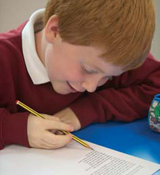Avoid placing too much emphasis on summative assessment when setting targets, suggests Liz Taylor...
These are some of the responses I received when I asked a number of children from different schools to discuss and record the key elements of a ‘good story’ prior to a writing lesson. A few children included ‘structure’ and ‘paragraphs’ in their responses – but a significant majority identified ‘wow words’ and ‘punctuation’ as their overall top choices
Of course, when children are learning to write it is important they focus on such elements as choice of synonyms, sentence organisation, and appropriate punctuation. Each of the latter can provide a real challenge to the developing writer. But what sort of messages are children getting if it is the surface features of writing they list as being most important?
 The now defunct National Literacy Strategy Framework presented the English curriculum in bite-sized pieces; useful to help teachers plan relevant literacy links but leading, in some cases, to a fragmentation of the curriculum. The teaching of writing was particularly affected.
The now defunct National Literacy Strategy Framework presented the English curriculum in bite-sized pieces; useful to help teachers plan relevant literacy links but leading, in some cases, to a fragmentation of the curriculum. The teaching of writing was particularly affected.
At the same time, SATs mark schemes and related exemplar texts provided useful models for marking and ‘levelling’ writing – but may have contributed to a growing perception that you could teach children explicit marking criteria (e.g. use of metaphor; complex sentence) to ensure writing success.
The National Strategies assessment guidelines (APP) suggests 23 different descriptors for achieving level 3 in writing and although children ‘only’ need to gain most of these within a range of writing, it is still quite a disarming list. You can see how the over-conscientious teacher might feel somewhat despondent!
In most good schools, however, the APP and other similar assessment lists are used sparingly and predominantly for summative purposes. For instance, teachers have periodic ‘assessment weeks’ in which they review children’s progress in reading and writing and set new teaching and learning targets. But how useful are summative tick points in helping to plan new learning?
The problem with the criterionreferenced ‘tick sheet’ approach to assessment is the implication that there is a specific and universal route to progress, and that it can be tracked in a prescribed (if often vague) series of steps, e.g.:
• APP Af4 - level 3 – some links between sentences…
• APP Af4 - level 4 – limited range of links between sentences…
On the positive side, such systems can perform a key role in promoting discussion amongst teachers and giving a standardised approach to summative marking, particularly when the stakes for providing evidence of progress are so high.
But the danger comes when these mark schemes are used for specific target-setting - when all the evidence from research is that it is the use of effective formative assessment which best supports children’s progress in learning. This is particularly the case for children who find writing most challenging and who will not necessarily move speedily through summative drawn targets; in many cases struggling for some considerable time over, say, thepunctuation aspects of writing - believing these are the most critical elements to get right.
 The progress of the least and most able readers and writers can vary significantly. Try tracking the most able writers across year groups in your school. What does progress look like in the case of these children? You may well find evidence of ‘spiky’ profiles – or of similar writing qualities demonstrated in different age groups.
The progress of the least and most able readers and writers can vary significantly. Try tracking the most able writers across year groups in your school. What does progress look like in the case of these children? You may well find evidence of ‘spiky’ profiles – or of similar writing qualities demonstrated in different age groups.
Tracking the least confident writers will most likely give a different profile. Often as these children progress in writing they go on to produce lengthier texts, with some minimal expansion of content and vocabulary, but repeating the same kinds of structural, grammatical and spelling errors. For these children, the tick list and targeting approach to assessment often means they fail to meet the same targets year on year. As teachers we need to address this urgently.
There is much evidence arising from Assessment for Learning (AFL) research indicating that children who find writing difficult require careful scaffolding to help them with incremental progress. They need tasks and activities to help bridge the gap between what they currently achieve and what they can, with help, go on to achieve.
On the other hand, able writers can find incremental targets frustrating, as they are often better able to progress through supported experimentation and self-direction.
One of the models I recommend for formative assessment of writing, or AFL (and this can be applied to any genre) focuses in on three simple categories of writing:
1. Composition (e.g. overall form and content including use of language)
2.Organisation (e.g. how clauses, sentences, paragraphs are ordered and connected)
3. Accuracy (e.g. spelling, punctuation and, in some cases, handwriting)
One of the advantages of using only three criteria for formative assessment is that it encourages teacher and/or pupil to examine the whole text, in order to decide which aspect requires the most attention for assessing/reviewing at any one time.
Where patterns of difficulty occur with the work of individuals or groups of children, then tasks or activities that focus on specifically addressing the nature of the problem will support the writer’s progress (see right).
Formative assessment and scaffolded tasks…
The simple text based ideas and routines suggested below help teachers use formative assessment to plan appropriate tasks. None of the ideas are particularly new, but reinforce the need to move from ticking and targeting routines to genuinely matched work that supports all children in their writing.
1. Composition
Look to develop text building structures, through drama, role play and discussion. For less confident writers in particular, introduce them to work involving simple models of texts that they themselves can aspire to write; texts that are just a stage further advanced than they can currently write themselves.
2. Organisation
As a paired activity, encourage the reconstruction of text(s) which have been divided into smaller sections, such as clauses, sentences, paragraphs to be reordered. For the less confident child, these should be pitched just above the level at which they can organise their own writing.
3. Accuracy
Redrafting whole texts can be torturous – especially for the less confident! Keep checking and redrafting to a minimum per text written, but make it a regular activity undertaken with short text sections or episodes.
Liz Taylor is PGCE tutor in primary education at the Institute of Education, London. She taught for 17 years in London before becoming an LEA advisory teacher and then a OFSTED inspector.
Boosting children’s self esteem
Ace-Classroom-Support
8 Ways To Get Your Class Drawing
Ace-Art-And-Design
Help Pupils Tell Fact From Fiction In The Digital World
Ace-Computing
Top tips for differentiation
Ace-Maths
